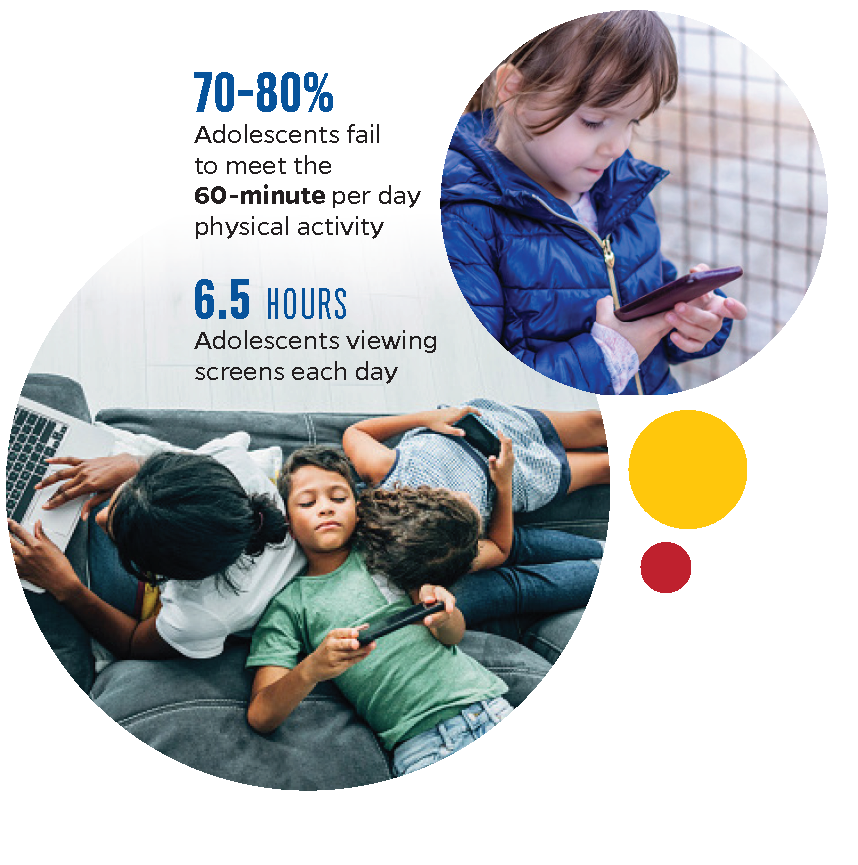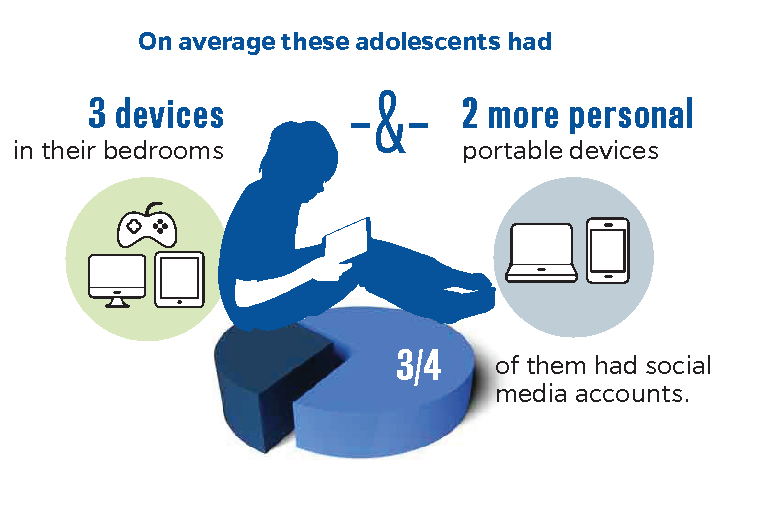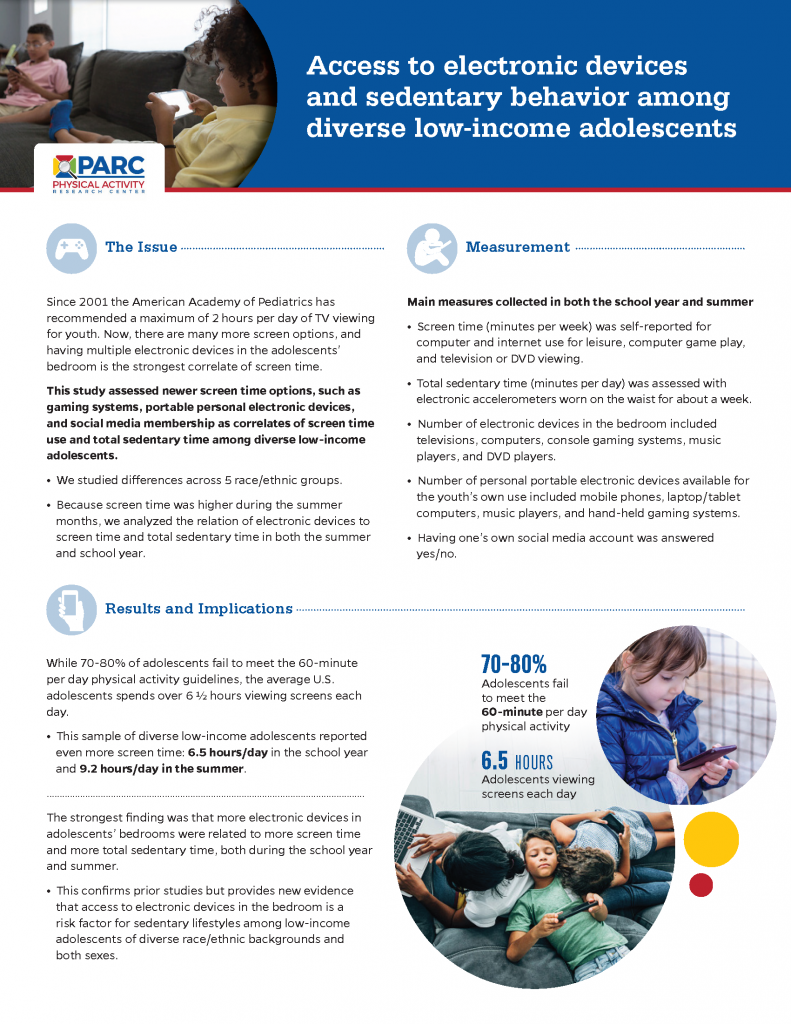Electronic Devices as Correlates of Sedentary Behavior and Screen Time Among Diverse Low-Income Adolescents During the School Year and Summer Time
By: James F. Sallis, Terry L. Conway, Kelli L. Cain, Carrie Geremia, Edith Bonilla, Chad Spoon, University of California San Diego
Since 2001 the American Academy of Pediatrics has recommended a maximum of 2 hours per day of TV viewing for youth. Now, there are many more screen options, and having multiple electronic devices in the adolescents’ bedroom is the strongest correlate of screen time.
This study assessed newer screen time options, such as gaming systems, portable personal electronic devices, and social media membership as correlates of screen time
use and total sedentary time among diverse low-income adolescents.
- We studied differences across 5 race/ethnic groups.
- Because screen time was higher during the summer months, we analyzed the relation of electronic devices to screen time and total sedentary time in both the summer and school year.
Measurement
- Screen time (minutes per week) was self-reported for computer and internet use for leisure, computer game play, and television or DVD viewing.
- Total sedentary time (minutes per day) was assessed with electronic accelerometers worn on the waist for about a week.
- Number of electronic devices in the bedroom included televisions, computers, console gaming systems, music players, and DVD players.
- Number of personal portable electronic devices available for the youth’s own use included mobile phones, laptop/tablet computers, music players, and hand-held gaming systems.
- Having one’s own social media account was answered yes/no.
Results and Implications

- While 70-80% of adolescents fail to meet the 60-minute per day physical activity guidelines, the average US adolescent spends over 6 ½ hours viewing screens each day.
- This sample of diverse low-income adolescents reported even more screen time: 6.8 hours/day in the school year and 9.2 hours/day in the summer.
- The strongest finding was that more electronic devices in adolescents’ bedrooms were related to more screen time and more total sedentary time, both during the school year and summer.
- This confirms prior studies but provides new evidence that access to electronic devices in the bedroom is a risk factor for sedentary lifestyles among low-income adolescents of diverse race/ethnic backgrounds and both sexes.
- There was a pattern that electronic devices in the bedroom tended to be more related to screen time and total sedentary behavior in the summer.
- This could be explained by adolescents spending more time in the bedroom during the summer and perhaps less parental supervision in the summer.
- There was little evidence that number of personal electronic devices was related to screen time or sedentary behavior of low-income adolescents.
- These portable devices do not require users to be sitting, so their use does not appear to be a strong risk factor for sedentary lifestyles. For example, adolescents often talk on their mobile phones or listen to music while moving around.

- This is the first study to examine social media accounts as a correlate of sedentary behaviors, and the findings were inconsistent. The complexity of the impact of social media accounts was indicated by different effects across race/ethnic groups.
- Social media membership was related to more sedentary time among African American, American Indian, and White/non-Hispanic adolescents, but less sedentary time among Latinos and Asian/Pacific Islanders.
- Adolescents’ access to their own electronic devices is extremely common, even among these lower-income adolescents.
- On average these adolescents had 3 devices in their bedrooms and 2 more personal portable devices. Three-quarters of them had social media accounts.
- In conclusion, having multiple electronic devices in bedrooms was confirmed as a risk factor for more screen time and total sedentary behavior in this study of highly-diverse lower-income adolescents.
- Access to these devices is common enough, even in lower-income households, to warrant interventions. Thus, parents and guardians are encouraged to restrict electronic devices in adolescents’ bedrooms.
Findings from this lay summary are available in the full article, published in Journal of Healthy Eating and Active Living:
Sallis, JF, Conway TL, Cain KL, Geremia C, Bonilla E, & Spoon C. Electronic Devices as Correlates of Sedentary Behavior and Screen Time Among Diverse Low-Income Adolescents During the School Year and Summer Time. Journal of Healthy Eating and Active Living. 2020
Suggested Citation for Lay Summary:
Sallis, JF, Conway TL, Cain KL, Geremia C, Bonilla E, & Spoon C. Electronic Devices as Correlates of Sedentary Behavior and Screen Time Among Diverse Low-Income Adolescents During the School Year and Summer Time: A Lay Summary. San Diego, CA: Physical Activity Research Center and University of California San Diego; 2020.
This lay summary was made possible with funding from the Physical Activity Research Center. The research that generated the lay summary was led by Drs. James F. Sallis and Terry L. Conway from the University of California San Diego.

